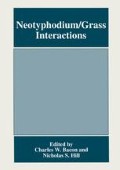Abstract
In the twenty years since the first report of an ergot alkaloid-producing endophytic fungus being the causal agent of grass-associated toxicoses in livestock (Bacon et al., 1977), the production of these alkaloids are now well documented among several grass endophytes of the family Clavicipitaceae (Porter, 1994). These endophytes have been shown to convey to the host grasses certain advantageous physiological and ecological characteristics such as increased vigor, tolerance, and resistance to drought and pests (West, 1994; Rowan and Latch, 1994). Research interests have begun to focus on the potential manipulation of the fungi to retain the beneficial qualities communicated to the plant but to down-regulate or eliminate the production of toxicosis-inducing ergot alkaloids (Schardl, 1994). However, little attention has been given to the distribution of these alkaloids within the Clavicipitaceae. While select species of grass endophytes within the genera Neotyphodium, Epichloë, and Balansia have been assayed for alkaloid production, a broad sampling of the entire family is lacking, especially among the entomopathogenic species. We have undertaken such a sampling within a phylogenetic construct and have assayed ergot alkaloid production by certain grass associates and by several species of entomopathogenic Cordyceps with the objective of more clearly defining the evolutionary history, derivation, and biological significance of ergot alkaloids within the family.
Access this chapter
Tax calculation will be finalised at checkout
Purchases are for personal use only
Preview
Unable to display preview. Download preview PDF.
References
Bacon, C. W. 1988. Procedure for isolating the endophyte from tall fescue and screening isolates for ergot alkaloids. Appl. Environ. Microbiol. 54: 2615–2618.
Bacon, C.W., J.K. Porter, J.D. Robbins, and E.S. Luttrell. 1977. Epichloë typhina from toxic tall fescue grasses. Appl. Environ. Microbiol. 34: 576–581.
Glenn, A.E., C.W. Bacon, R. Price, and R.T. Hanlin. 1996. Molecular phylogeny ofAcremonium and its taxonomic implications. Mycologia 88: 369–383.
Maddison, W.P., and D.R. Maddison. 1992. MacClade: Analysis of Phylogeny and Character Evolution, version 3. 03. Sinauer Associates, Inc., Sunderland, Massachusetts.
Porter, J.K. 1994. Chemical constituents of grass endophytes. Pp. 103–123. In: Biotechnology of Endophytic Fungi of Grasses. Eds., C.W. Bacon and J.F. White, Jr. CRC Press, Boca Raton.
Rowan, D.D., and G.C.M. Latch. Utilization of endophyte-infected perennial ryegrasses for increased insect resistance. Pp. 169–183. In: Biotechnology of Endophytic Fungi of Grasses. Eds., C.W. Bacon and J.F. White, Jr. CRC Press, Boca Raton.
Schardl, C.L. 1994. Molecular and genetic methodologies and transformation of grass endophytes. Pp. 151–165. In: Biotechnology of Endophytic Fungi of Grasses. Eds., C.W. Bacon and J.F. White, Jr. CRC Press, Boca Raton.
Swofford, D.L. 1993. PA UP: Phylogenetic Analysis Using Parsimony, version 3.1. 1. Illinois Natural History Survey, Champaign, Illinois.
Vilgalys, R., and M. Hester. 1990. Rapid genomic identification and mapping of enzymatically amplified ribosomal DNA from several Cryptococcus species. J. Bacteriol. 172: 4238–4246.
West, C.P. 1994. Physiology and drought tolerance of endophyte-infected grasses. Pp. 87–99. In: Biotechnology of Endophytic Fungi of Grasses. Eds., C.W. Bacon and J.F. White, Jr. CRC Press, Boca Raton.
White, T.J., T. Bruns, S. Lee, and J.W. Taylor. 1990. Amplification and direct sequencing of fungal ribosomal RNA genes for phylogenetics. Pp. 315–322. In: PCR Protocols: A Guide to Methods and Applications. Eds., M.A. Innis, D.H. Gelfand, J.J. Sninsky, and T.J. White. Academic Press, New York.
Author information
Authors and Affiliations
Editor information
Editors and Affiliations
Rights and permissions
Copyright information
© 1997 Springer Science+Business Media New York
About this chapter
Cite this chapter
Glenn, A.E., Bacon, C.W. (1997). Distribution of Ergot Alkaloids within the Family Clavicipitaceae. In: Bacon, C.W., Hill, N.S. (eds) Neotyphodium/Grass Interactions. Springer, Boston, MA. https://doi.org/10.1007/978-1-4899-0271-9_7
Download citation
DOI: https://doi.org/10.1007/978-1-4899-0271-9_7
Publisher Name: Springer, Boston, MA
Print ISBN: 978-1-4899-0273-3
Online ISBN: 978-1-4899-0271-9
eBook Packages: Springer Book Archive

